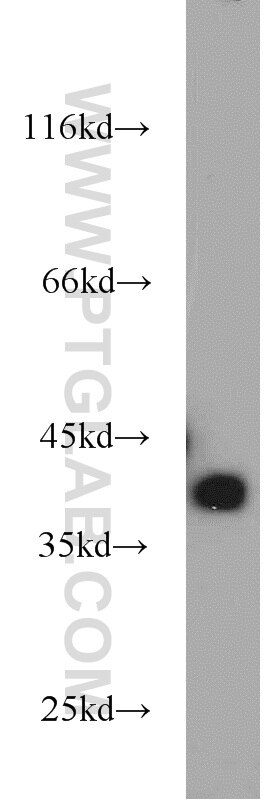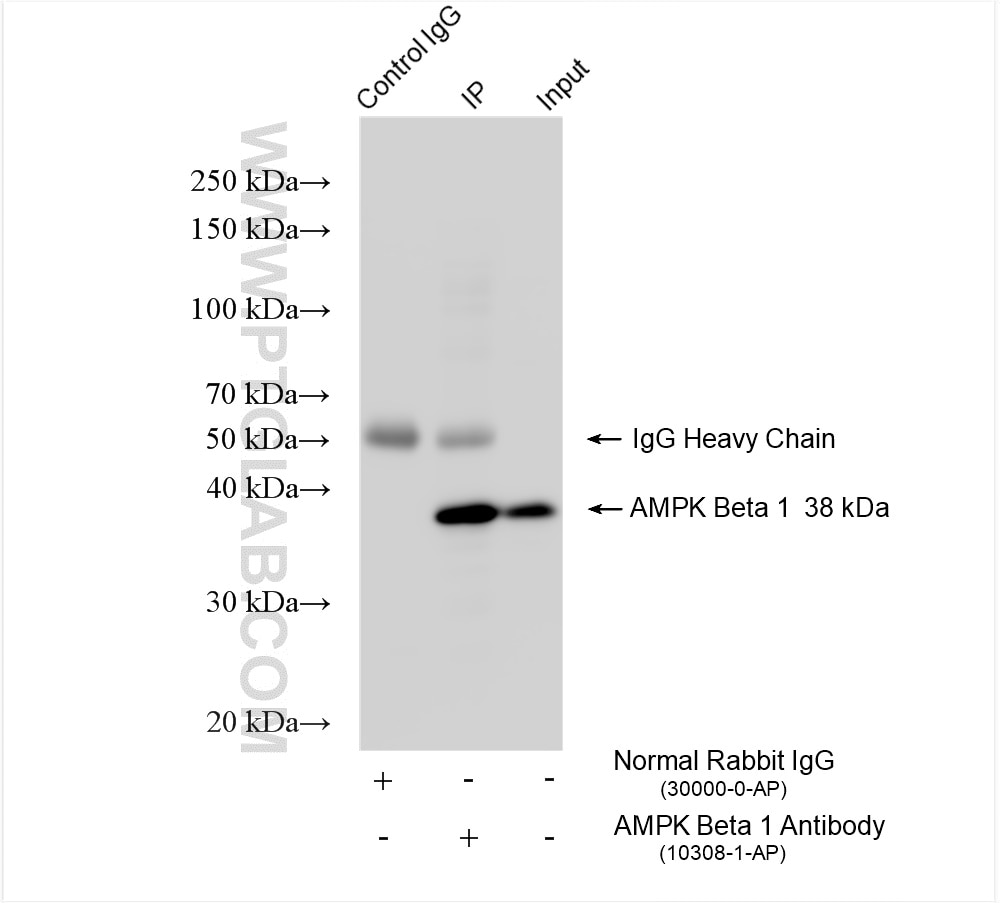- Phare
- Validé par KD/KO
Anticorps Polyclonal de lapin anti-AMPK Beta 1
AMPK Beta 1 Polyclonal Antibody for WB, IHC, IF/ICC, IP, ELISA
Hôte / Isotype
Lapin / IgG
Réactivité testée
Humain, souris et plus (1)
Applications
WB, IHC, IF/ICC, IP, ELISA
Conjugaison
Non conjugué
N° de cat : 10308-1-AP
Synonymes
Galerie de données de validation
Applications testées
| Résultats positifs en WB | tissu hépatique de souris, cellules A431, cellules HEK-293, cellules HeLa |
| Résultats positifs en IP | tissu hépatique de souris, |
| Résultats positifs en IHC | tissu de cancer du poumon humain il est suggéré de démasquer l'antigène avec un tampon de TE buffer pH 9.0; (*) À défaut, 'le démasquage de l'antigène peut être 'effectué avec un tampon citrate pH 6,0. |
| Résultats positifs en IF/ICC | cellules HeLa, |
Dilution recommandée
| Application | Dilution |
|---|---|
| Western Blot (WB) | WB : 1:500-1:2000 |
| Immunoprécipitation (IP) | IP : 0.5-4.0 ug for 1.0-3.0 mg of total protein lysate |
| Immunohistochimie (IHC) | IHC : 1:50-1:500 |
| Immunofluorescence (IF)/ICC | IF/ICC : 1:200-1:800 |
| It is recommended that this reagent should be titrated in each testing system to obtain optimal results. | |
| Sample-dependent, check data in validation data gallery | |
Applications publiées
| KD/KO | See 2 publications below |
| WB | See 11 publications below |
| IF | See 2 publications below |
| IP | See 1 publications below |
Informations sur le produit
10308-1-AP cible AMPK Beta 1 dans les applications de WB, IHC, IF/ICC, IP, ELISA et montre une réactivité avec des échantillons Humain, souris
| Réactivité | Humain, souris |
| Réactivité citée | rat, Humain, souris |
| Hôte / Isotype | Lapin / IgG |
| Clonalité | Polyclonal |
| Type | Anticorps |
| Immunogène | AMPK Beta 1 Protéine recombinante Ag0301 |
| Nom complet | protein kinase, AMP-activated, beta 1 non-catalytic subunit |
| Masse moléculaire calculée | 38 kDa |
| Poids moléculaire observé | 38 kDa |
| Numéro d’acquisition GenBank | BC001007 |
| Symbole du gène | PRKAB1 |
| Identification du gène (NCBI) | 5564 |
| Conjugaison | Non conjugué |
| Forme | Liquide |
| Méthode de purification | Purification par affinité contre l'antigène |
| Tampon de stockage | PBS avec azoture de sodium à 0,02 % et glycérol à 50 % pH 7,3 |
| Conditions de stockage | Stocker à -20°C. Stable pendant un an après l'expédition. L'aliquotage n'est pas nécessaire pour le stockage à -20oC Les 20ul contiennent 0,1% de BSA. |
Informations générales
AMPK Beta 1 (5'-AMP-activated protein kinase subunit beta-1) is also named as PRKAB1 and AMPK. AMPK, a serine/threonine kinase that exists as a heterotrimer comprised of a catalytic α-subunit and regulatory β- and γ-subunits, has been recognized as a sensor of cellular energy homeostasis (PMID: 21937710). AMPK regulates key metabolic enzymes, cell growth, apoptosis, gene transcription, and protein synthesis (PMID: 12829246). AMPK is an energy sensor and plays an essential role in the control of cellular bioenergetics by responding to various stresses including those that induce changes in the cellular AMP:ATP ratio or modulation in intracellular calcium (PMID: 27812976, PMID: 26616193). Recent studies have shown that AMPK mediates the inhibition of cell proliferation and growth of tumor cells (PMID: 16613876). AMPK also inhibits the expression of Glut1 and glycolysis in Tregs by inhibiting mTORC1 signaling (PMID: 25477880).
Protocole
| Product Specific Protocols | |
|---|---|
| WB protocol for AMPK Beta 1 antibody 10308-1-AP | Download protocol |
| IHC protocol for AMPK Beta 1 antibody 10308-1-AP | Download protocol |
| IF protocol for AMPK Beta 1 antibody 10308-1-AP | Download protocol |
| IP protocol for AMPK Beta 1 antibody 10308-1-AP | Download protocol |
| Standard Protocols | |
|---|---|
| Click here to view our Standard Protocols |
Publications
| Species | Application | Title |
|---|---|---|
Cell Metab CircACC1 Regulates Assembly and Activation of AMPK Complex under Metabolic Stress.
| ||
Acta Pharm Sin B Engineering cannabidiol synergistic carbon monoxide nanocomplexes to enhance cancer therapy via excessive autophagy | ||
Theranostics Therapeutic inhibition of miR-802 protects against obesity through AMPK-mediated regulation of hepatic lipid metabolism. | ||
J Ethnopharmacol Mulberry leaves attenuate D-galactose-induced aging in vivo and in vitro | ||
Hum Cell RNF126 contributes to stem cell-like properties and metastasis in hepatocellular carcinoma through ubiquitination and degradation of LKB1 | ||
Dig Dis Sci Heme Oxygenase-1-Modified BMMSCs Activate AMPK-Nrf2-FTH1 to Reduce Severe Steatotic Liver Ischemia-Reperfusion Injury |









